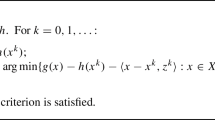Abstract
To date, the spin glass paradigm has been gainfully used in solving a number of optimization problems by devising a mapping between our understanding of spin interactions within a natural spin glass and the given optimization problems. Among the determining factors in a natural spin glass, phase transition is a physical phenomenon that is controlled by temperature. Depending on the spin glass’s phase, spin glasses behave differently and may or may not reach the globally desired optimum. This study aims to determine this critical temperature below which convergence to a global optimum is more likely. Furthermore, we aim to determine the main parameters that characterize this critical temperature. Specifically, the critical temperature is studied as applied to the portfolio selection problem. It is shown that below the critical temperature, the glass consistently reaches the optimal states, whereas, convergence to optimum becomes increasingly unlikely if temperature exceeds this critical temperature. Application to five of the world’s major financial markets reveals that the critical temperature is directly proportional to covariance and the average return of assets and does not depend on the number of assets. In other words, all stock markets, that have the same asset covariance and average return, also have the same critical temperature. This is confirmed by several empirical tests such as correlation, entropy and hamming distance.








Similar content being viewed by others
References
Ackley DH, Hinton GE, Sejnowski TJ (1985) A learning algorithm for Boltzmann machines. Cogn Sci 9:147–169
Bar-Yam Y (1997) Dynamics of Complex Systems. Addison Wesley Longman Inc., Amsterdam, pp 146–180
Bar-Yam Y (2005) About Engineering Complex Systems: Multiscale Analysis and Evolutionary Engineering. Springer Verlag, Berlin, pp 16–31
Berthier L, Young AP (2004) Time and length scales in spin glasses. J Phys Condens Matter 16:S729–S734
Boettcher S (1999) Extremal Optimization of graph partitioning at the percolation threshold. J Phys A Math Gen 32:5201–5211
Boettcher S (2004) Extremal optimization at the phase transition of the 3-coloring problem. Phys Rev E Stat Nonlin Soft Matter Phys 69(6 Pt 2):066703
Bolthausen E, Bovier A (2007) “Spin Glasses,” Springer-Verlag, Berlin
Bulatov AA, Skvortsov ES (2008) “Phase transition for Local Search on planted SAT,” arXiv:0811.2546v1
Ciliberti S, Mezard M (2007) Risk minimization through portfolio replication. Europ Phy J B 57:175–180
Coppersmith D, Gamarnik D, Hajiaghayi M, Sorkin GB (2003) Random max sat, random max cut, and their phase transitions. J Rand Struct Algorithm 24(4):502–545
Gabor A, Kondor I (1999) Portfolio with nonlinear constraints and spin glasses. Phys A 274:222–228
Galluccio S, Bouchaud JP, Potters M (1998) Rational decisions, random matrices and spin glasses. J Phy A 259:449–456
Gent IP, Walsh T (1996) The TSP phase transition. Artif Intell 88:349–358
Hartmann AK, Rieger H (2002) “Optimization Algorithms in Physics,” Wiley-VCH Verlag Co, Cambridge
Hartmann AK, Weigt M (2005) “Phase Transitions in Combinatorial Optimization Problems, Basics, Algorithms and Statistical Mechanics,” Wiley-VCH Verlag Co, Cambridge
Hinton GE, Sejnowski TJ, Rumelhart DE, McClelland JL (1986) Learning and Relearning in Boltzmann Machines. Cambridge MIT Press, Cambridge, pp 282–317
Horiguchi T, Takahashi H, Hayashi K, Yamaguchi C (2004) Ising model for packet routing control. J Phy Lett A 330:192–197
Hubermann BA, Hogg T (1987) Phase transitions in artificial intelligence systems. J Artif Intell 33:155–171
Ingber L (1993) Simulated annealing: Practice versus theory. Math Comput Model 18(11):29–57
Lotov AV (2005) Approximation and Visualization of Pareto Frontier in the Framework of Classical Approach to Multi-Objective Optimization. In: Dagstuhl Seminar Proceedings 04461, Practical Approaches to Multi-Objective Optimization, pp 235
Markowitz H (1952) Portfolio Selection. J Finan 7:77–91
Mooij JM, Kappen HJ (2004) Spin-glass phase transitions on real-world graphs. arXiv:0408378v2
Nishimori H (2001) Statistical Physics of Spin Glasses and Information Processing: An introduction. Clarendon press Oxford, Oxford
Nishimori H (2007) Spin glasses and information. Phys A 384:94–99
Nordblad Per (2004) Spin glasses: model systems for non-equilibrium dynamics. J Phys Condens Matter 16:S715–S722
Sarkar P (2000) A brief history of cellular automata. ACM Comput Surv 32(1):80–107
Sivanandam SN, Deepa SN (2008) “Introduction to Genetic Algorithms,” Springer-Verlag, Berlin
Vafaei Jahan M, Akbarzadeh-T MR (2010) From local search to global conclusions: migrating spin glass-based distributed portfolio selection. IEEE Trans Evolut Comput 14(2):591–601
Vafaei Jahan M, Akbarzadeh Totonchi MR (2012a) Composing local and global behavior: higher performance of spin glass based portfolio selection. J Comput Sci 3(4):238–245
Vafaei Jahan M, Akbarzadeh Totonchi MR (2012b) Extremal optimization vs. learning automata: strategies for spin selection in portfolio selection problems. Appl Soft Comput 12(10):3276–3284
Waelbroeck H, Zertuche F (1999) Discrete chaos. J Phys A Math Gen 32(1):175–189
Wang F, Landau DP (2001) An efficient, multiple range random walk algorithm to calculate the density of states. Phys Rev Lett 86(10):2050–2053
Portfolio selection benchmark data at http://people.brunel.ac.uk/~mastjjb/jeb/orlib/portinfo.html
Young AP (2007) Phase transitions in spin glasses. J Magn Magn Mater 310:1482–1486
Zhang W, Korf R (1996) A study of complexity transitions on the asymmetric traveling salesman problem. J Artif Intell 81(2):223–239
Author information
Authors and Affiliations
Corresponding author
Additional information
Communicated by V. Loia.
Rights and permissions
About this article
Cite this article
Jahan, M.V., Akbarzadeh-T, MR. & Shahtahamassbi, N. A study of phase transitions for convergence analysis of spin glasses: application to portfolio selection problems. Soft Comput 17, 1883–1892 (2013). https://doi.org/10.1007/s00500-013-1025-7
Published:
Issue Date:
DOI: https://doi.org/10.1007/s00500-013-1025-7




